| Applications | |
ICT as a catalyst of urban transformation
A smart city provides infrastructure services such as water, energy and transportation, with the intelligent networks, sustainable buildings and systems |
 |
|
Urban Population in India increased from 62 million (19%) in 1951 to 377 million (31%) in 2011, and is expected to increase up to around 37% by 2021. Consequently, the number and size of cities have also increased considerably. As per 2011 census, over 833 million Indians live in 6.4 lakh villages and 377 million live in 7935 urban centres.
The census towns have increased by 2,774 between 2001 and 2011. However, the growth of urban infrastructure did not match with the growth of urban population. Indian cities are facing the challenges of infrastructure services and housing shortage (18.78 million Dwelling Units). 24% (94.98 million) of urban population still lives in slums. The status of drinking water supply, public transportation, sewage and solid waste management is much lower than desired. Only 74% of households are served by piped water and just 65 out of 423 class 1 cities have a formal bus city service (2012). Traffic delays cost Rs 40 billion annually. Only 30 per cent of cities have sewage treatment, 32.7% of urban population has access to the municipal sewer system and 12.6% of urban population still defecates in the open. In Indian cities, only 72% of the solid waste is collected and only 30% is segregated, with a poor treatment and disposal. More than 80% of cities do not have statutory plans.

12th Five Year Plan
The objective of the 12th Plan is faster, more inclusive, innovative, equitable and sustainable growth. It aims at cities which are free from slums and provide adequate opportunities for productive employment and decent quality of life to all its inhabitants. The cities would be the engines of growth and by attracting the investments nationally and internationally, they must be transformed to provide world-class infrastructure services, viz:
• Affordable housing
• Sustainable livelihood and enterprise
• Universal access to water supply and sanitation
• Quality and affordable public transport
• Clean and healthy environment
The strategy to deliver these targets comprises five enablers:
• Strengthen local governance systems
• Integrate planning organization and processes
• Build capacity across all levels
• Financially empower ULBs
• Promote innovation in urban management
The innovation has a key role to play in transforming the cities. The 12th Five Year Plan aims to promote innovation and technology which would unlock significant potential in building capacity across the ULBs, related to operations and maintenance in areas like water supply and sanitation, solid waste management, transport, infrastructure, health and education and urban planning. Indicative outlays of Rs 1,20,557 crore for Ministry of Urban Development (MOUD) and Rs 43,521 crore for Ministry of Housing and Urban Poverty Alleviation (MOHUPA) have been made, which include a provision of Rs 1,01,917 crore for the JNNURM (MOUD Rs 66,246 crore and MOHUPA Rs 35,671 crore)
The concept of innovation and Smart City
With the aim of making cities equitable, inclusive, smart and environmentally sustainable, the ICT has a key role to play in leveraging IT systems and innovations. Cities are complex systems which involve multiple stakeholders, agencies, departments and organizations. It is a necessity to innovate and respond to a new generation in terms of communication, health, education, recreation and urban services, while efficiently running daily operations. It must provide services that support the social, health and educational needs of citizens. A smart city provides infrastructure services such as water, sanitation, drainage, SWM, sewage, energy and transportation with intelligent networks, sustainable buildings and systems. A smart city focuses on intelligent computing infrastructure with cutting–edge advances in cyber–physical systems, and innovation support. Since a city is composed of numerous buildings, these also need to be smart and green. By innovation and renewal of existing operations it may be possible to reduce energy consumption. Integration of major systems on a common network helps optimize use assignment and space configurations, eliminating unused or underperforming space.
The breakthrough in technology has multiplied the space, energy and time. It has now been realized that ‘less is more’ with the application of microchips, micro-computers, microwaves, nano– technology, etc. The buildings and services are yet to capture this breakthrough. It is time that new forms of energy, services and construction are evolved. Renewal energy and recycling must be the key concepts in services and buildings. A new pattern of shrinking space and time is emerging. The network of society, cyber–space and e–topia is changing the familiar borders like inside–outside, private–public, here–there, city–country and yesterday–tomorrow. The world of space and place is characterized by online exchange of information, interactions, dynamic networks and floating nodes.
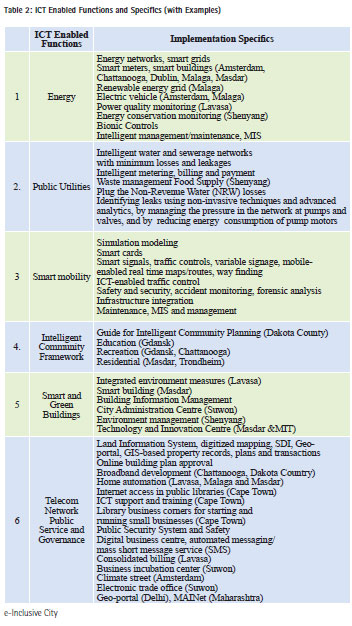
Environmental sustainability is important in a world where resources are scarce and where cities increasingly base their development and wealth on natural resources. Their exploitation must guarantee a safe and renewable use of natural resources. The availability and quality of the ICT infrastructure is essential for a smart or intelligent city. However, it is also necessary to stress the role of human capital, education and learning in urban development. It has been shown that the most rapid urban growth rates have been achieved in cities where a high share of educated labor force is available. Innovation is driven by entrepreneurs who innovate in industries and products which require an increasingly more skilled labor force. Because not all cities are equally successful in investing in human capital, an educated labor force – ‘the creative class’ – is spatially clustering over time. This makes the cities diverse in terms of human capital, and the cities which are endowed with a skilled human resource, have managed to achieve spatial homogeneity by progressive clustering of human capital.
ICT has the potential to play the role of a catalyst for the transformation of a city into a smart city with integrated and open interface of information management and governance platform. Urban development and transformation are intrinsically linked to the knowledge-based society where innovation and technology are main drivers of growth collective community intelligence and local capacity. This requires a planning paradigm pertinent for local-urban-regional development and innovation management. By developing sector–focused, cluster–based intelligent city strategies, territories can set in motion innovation mechanisms of global dimensions and enhance substantially their services and systems. The critical factors are those that affect use of resources and carbon emissions, such as energy use, transportation, waste prevention and recycling, air quality, water quality, affordable housing, green space and buildings. This implies the need to rethink and reshape the urban environment, comprising transportation infrastructure, zoning, building codes, waste management, open space and greens, etc., which make the city more efficient, sustainable, and smart. ICT can help in the integration of citizen participation, governance and online consultation over plans and programmes of local development.
As per Gartner Research Note (Sept. 2011), ‘A smart city is a sustainable urban area utilizing information and communication flows between systems in different vertical domains, such as utilities, transportation, healthcare, public safety and education. Such flow of information, as well as their impact on services are analyzed and acted on in order to make the city’s wider urban eco-system more resource-efficient and sustainable.’ Intelligent Network and Sensors make services, buildings and mobility energy efficient and reduce carbon emission, which make a city smart. The smart city concept includes the following:
i) Smart Energy: The smart grid is all about creating the capabilities of electricity demand and supply to interact intelligently and integrate renewable generation. Geothermal heating and cooling system by circulating water through a grid of underground tunnels and wells, where the earth’s temperature is 15°C to 20°C, can provide environmentfriendly solutions to micro-climate and energy needs. The living pattern and city services should manifest a circular metabolism, replacing the existing linear system of input-output.
ii) Smart utilities aim at high quality water supply, drainage, sewerage, streets, waste management in catering to growing population. Recycling of waste water, rain water harvesting, coupled with waterless toilets contribute in saving the environment and avoid impending water crisis. For water supply, ICT solutions such as SCADA system enable enhanced efficiency and transparency. Similar benefits are available with respect to solid waste management and other utilities. It is difficult to conceive of urban infrastructure without ICT solutions. Common Utility Ducts or tunnels carrying electricity, water, pneumatic waste ducts, cable television and broadband internet minimize damage from traffic, road repairs, rains, etc., and make repairs easier. A series of low carbon zones across the city with co-located trigeneration energy systems (combing power, cooling and heating), dual piping for recycled water and automated, segregated waste collection and recycling would lead to bundling ‘green infrastructure’ together. Solid waste extracted from sewage at treatment plants can be burned to make electricity. Three bins recycling system adopt separate bins for trash, recyclable and compost. Collection charges drop as trash drops. Bio-technology, enzyme-based STP, bio-remedial treatment, sludge gas/energy recovery, vermi-culture, fossilization and composting options should be explored for waste treatment. Water-saving toilets (with recycled wastewater cistern) and water tanks can save millions of water. Satellite controlled park and lawn micro-irrigation system cuts water consumption and pumping power. Wastewater recycling, with dual piping would reduce water demand. Vertical farms could reduce fertilizer and freshwater use, shorten transport and recycle gray water. Taxing property owners on the volume of storm-water and waste-water from kitchen and toilets that runs off promotes retrofits that reduce wastewater volume. Zerorun off, swales, porous paving, biodrainage and storm-surge gates in river, drains and canals can protect low lying areas and infrastructure from floods and reduce drainage load.
iii) Smart Mobility: Effective public transport and improved traffic flow are necessary for a safer, comfortable and inclusive mobility with reduced emission. Intelligent transport solutions can provide seamless, safer, efficient and effective management of public transport systems. Similar results are also visible with the use of IT in the planning and management of transport infrastructure and services like taxies, autos, goods transport, signaling system, signage, transport simulation, etc.
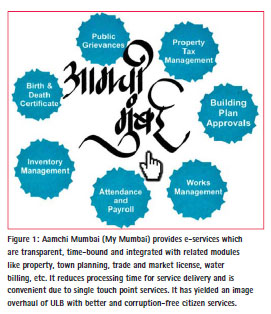
iv) Intelligent Community Frameworks: Community facilities such as health, education, recreational and other neighborhood services need to be planned to the highest standards of leadership in energy and environmental design (LEEDS) that save energy, materials and emissions. A smart neighborhood strives to achieve infrastructure efficiency, conservation of water, energy and natural resources.
v) Smart and Green Buildings can give energy saving up to 30%, reduce carbon emissions, provide higher efficiency and comfort with lesser energy consumption. The city and buildings have not only to be comfortable, green and efficient, but also intelligent and integrated. Rooftop PVC and solar panel can generate electricity instead of power plants and also shade rooftops to lower a building’s cooling needs. Solar energy can be collected through a decentralized grid for distribution. Solar panels on the roof move as the sun moves across the sky. Rooftops painted white reflect heat, lowering a building’s cooling cost and a city’s heat build-up. Rooftop vegetation can insulate building against heat and cold and absorbs storm-water. Super-insulated windows quadruple the thermal performance of double panes and can be made from the glass in existing windows. A sensor controlled photo-voltaic cell fits between two panes of a window. Smart glass technology saves on air- conditioning and high energy cost.
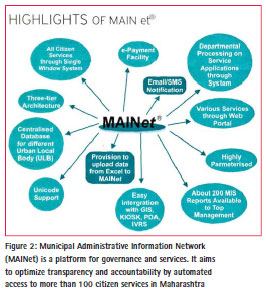
vi) Telecom Network, Public Services and Governance: ICT can enable coordination and e-governance, together with sharing the information amongst the various city departments, residents and other stakeholders.
In any city there are more than 100 citizen services that require engagement with civic authorities for enquiries, registration, form submissions, payments, grievances, etc. It is a time taking process for the citizen. The availability of e-gateway for citizen service delivery has attracted much attention in municipal governance and bringing out a silent revolution in many city corporations, breaking away barriers of distance, class and gender. The GIS enables any citizen to take a photo on mobile and send an SMS to the administration. The dashboard will capture and address the complaint and even escalate the matter to higher authorities, if unaddressed. Mumbai has 60 layered features of GIS mapping which is geo-referenced. The key municipal services provided online by Mumbai Mahanagar Palika include the following:
• Complaint redressal platform
• Town planning permission and licensing
• Water and property tax administration
• Public works – estimates and payments
• Octroi management
• Birth and death certificate
• Property registration
• Land services and slum surveys
• GIS-based Spatial Data Infrastructure.
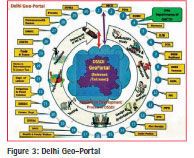
Geo- Portal
The Delhi geo-portal aims to bring together various line departments on a platform for e-service delivery. The system is mobile and internet-based, dynamically scalable. It helps in technology enabled management of land and infrastructure, planning, development. This yields better coordination and exchange of information, cost and time management. Citizen engagement becomes much easier and viable by virtual Town Hall interactions. Hybrid data centre, which is integrated yet decentralized, virtualizes the resources according to the requirements of each department. The geo-portal infrastructure platform enables ‘Infrastructure as a Service (IaaS)’ and ‘Platform as a Service (PaaS)’. It provides a virtual environment for the delivery of service. Besides responding to immediate demands, the geoportal creates a ‘future ready government’ with spread, speed and on-line e-service.
Conclusions
The 12th Five Year Plan envisages urban development as an engine of growth and socio-economic transformation. To achieve the objective of a faster, inclusive and sustainable growth, innovation and technology have been assigned a key role. In this context, ICT can be a catalyst in the provision of world-class, smart and intelligent infrastructure services (energy, water supply, utilities, mobility, green buildings, etc.), public services and governance. Some cities have successfully initiated ICT-based planning, development and services, which need to be up-scaled with spread and speed across all 640 districts and 7,935 towns and cities of India. The national urban programs such as JNNURM and RAY may mandate ICT-based geo-portal and e-inclusive governance in its reform agenda, which can be a catalyst of urban transformation.
References
1. Ahluwalia, M. S. : ‘Prospects and Policy Challenges in the Twelfth Plan’, Economic and Political Weekly, Vol. 46, 21, 2011, p. 88-105, 2011.
2. Census of India 2011, Provisional Census 2011, Government of India, New Delhi.
3. Government of India, Rajiv Awas Yojana – Guidelines for Slum- Free City Planning, Ministry of Urban Housing and Poverty Alleviation, New Delhi, 2010.
4. Government of India, Housing Conditions and Amenities in India, 2008-2009, Ministry of Statistics and Programme Implementation, NSSO, New Delhi, 2010.
5. Government of India, Report of High Power Committee on Urban Infrastructure (Isher Ahluwala Report), Ministry of Urban Development, New Delhi, 2011.
6. Government of India, Twelfth Five Year Plan, Planning Commission, Sage, New Delhi 2013
7. IBM Institute of Business Value Analysis, Making City Smart, web site
8. Jain A.K., Sustainable Urban Transport and Systems, Khanna Publishers, New Delhi, 2013
9. Jain A.K. Urban Land Policy and Public Private Partnership for Real Estate and Infrastructure Projects, Readworthy Publications, New Delhi, 2009.
10. Jain, A.K. Urban Housing and Slums, Readworthy Publications, New Delhi, 2009.
11. Jain, A. K. Making Infrastructure Work, Discovery Publishers, New Delhi, 2011.
12. Jain, A. K.The Informal City, Readworthy Publishers, New Delhi, 2011.
13. Jha Rachita, Bringing Urban Governance on an e-Platform, e-Governance, March 2012
14. McKinsey Global Institute, India’s Urban Awakening: Building Inclusive Cities, Sustaining Economic Growth, Mumbai, 2010.
15. UN-Habitat, Planning Sustainable Cities, Global Report on Human Settlements, Earthscan, UK/USA/ Nairobi, UN-Habitat, 2009.
16. UN-Habitat, Climate Change and Cities, Global Report on Human Settlements, Earthscan, UK/USA/ Nairobi, UN-Habitat 2010.
17. Wilbur Smith Associates, Traffic and Transport Policies and Strategies in Urban Areas in India, Ministry of Urban Development, New Delhi, 2008.













 (6 votes, average: 2.33 out of 5)
(6 votes, average: 2.33 out of 5)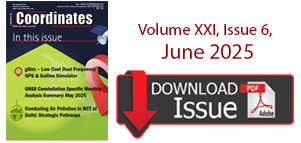





You have presented quite a comprehensive picture of what India needs and the role ICT can play. If your proposal (12th 5-year plan) is followed in honesty, a lot can be done. Alas, from my experience and knowledge of ICT deployment in India, I find the situation very grim. I had been involved in a few programs of DST towards Natural Resource Management and Infrastructural Planning way back in 90’s. There should have been substantial progress on this front. Certainly ICT can help India to find appropriate solutions using ICT (by innovative thinking) and address the various aspects of urban infrastructure management. How much thought really gets percolated down the line to the local administrators who hold the key to govt funding? Of course the problem is complicated by our governance system where political parties play to fulfill their own objective worrying least about the Planning Commission plans.
Leave your response!